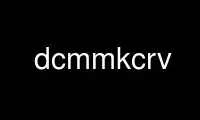
This is the command dcmmkcrv that can be run in the OnWorks free hosting provider using one of our multiple free online workstations such as Ubuntu Online, Fedora Online, Windows online emulator or MAC OS online emulator
PROGRAM:
NAME
dcmmkcrv - Add 2D curve data to image
SYNOPSIS
dcmmkcrv [options] dcmfile-in curvedata-in dcmfile-out
DESCRIPTION
The dcmmkcrv utility allows one to create DICOM images containing curve data. Since curve
data is hardly used by vendors today, this is intended as a means to test implementations
that can read curve data. The utility reads an existing DICOM image and a text file
containing the curve data in textual form. A DICOM curve data repeating group is created
according to the options specified on the command line, added to the existing image and
written back to file. The output file is encoded with the same transfer syntax used for
the input file. This utility only supports the creation of two-dimensional curves.
PARAMETERS
dcmfile-in DICOM input image file
curvedata-in curve data input file (text)
dcmfile-out DICOM output filename
OPTIONS
general options
-h --help
print this help text and exit
--version
print version information and exit
--arguments
print expanded command line arguments
-q --quiet
quiet mode, print no warnings and errors
-v --verbose
verbose mode, print processing details
-d --debug
debug mode, print debug information
-ll --log-level [l]evel: string constant
(fatal, error, warn, info, debug, trace)
use level l for the logger
-lc --log-config [f]ilename: string
use config file f for the logger
curve creation options
curve type:
-r --poly
create as POLY curve (default)
+r --roi
create as ROI curve
curve value representation:
+v --data-vr [n]umber: integer 0..4 (default: 4)
select curve data VR: 0=US, 1=SS, 2=FL, 3=FD, 4=SL
-c --curve-vr [n]umber: integer 0..2 (default: 0)
select VR with which the Curve Data element is written
0=VR according to --data-vr, 1=OB, 2=OW
repeating group:
-g --group [n]umber: integer 0..15 (default: 0)
select repeating group: 0=0x5000, 1=0x5002 etc.
curve description:
-l --label s: string
set Curve Label to s (default: absent)
+d --description s: string
set Curve Description to s (default: absent)
-a --axis x: string, y: string
set Axis Units to xy (default: absent)
NOTES
Syntax of the Curve Data File
The curve data file is expected to be a plain ASCII text file containing numbers (integer
or floating point) comprising the values of the point coordinates. Numbers must be
separated by whitespace. No checking of the value range or value range conversion is
performed. Example:
256.451947 1.000000
477.689863 128.822080
128.822080 477.689863
35.310137 128.822080
256.451947 1.000000
LOGGING
The level of logging output of the various command line tools and underlying libraries can
be specified by the user. By default, only errors and warnings are written to the standard
error stream. Using option --verbose also informational messages like processing details
are reported. Option --debug can be used to get more details on the internal activity,
e.g. for debugging purposes. Other logging levels can be selected using option --log-
level. In --quiet mode only fatal errors are reported. In such very severe error events,
the application will usually terminate. For more details on the different logging levels,
see documentation of module 'oflog'.
In case the logging output should be written to file (optionally with logfile rotation),
to syslog (Unix) or the event log (Windows) option --log-config can be used. This
configuration file also allows for directing only certain messages to a particular output
stream and for filtering certain messages based on the module or application where they
are generated. An example configuration file is provided in <etcdir>/logger.cfg.
COMMAND LINE
All command line tools use the following notation for parameters: square brackets enclose
optional values (0-1), three trailing dots indicate that multiple values are allowed
(1-n), a combination of both means 0 to n values.
Command line options are distinguished from parameters by a leading '+' or '-' sign,
respectively. Usually, order and position of command line options are arbitrary (i.e. they
can appear anywhere). However, if options are mutually exclusive the rightmost appearance
is used. This behavior conforms to the standard evaluation rules of common Unix shells.
In addition, one or more command files can be specified using an '@' sign as a prefix to
the filename (e.g. @command.txt). Such a command argument is replaced by the content of
the corresponding text file (multiple whitespaces are treated as a single separator unless
they appear between two quotation marks) prior to any further evaluation. Please note that
a command file cannot contain another command file. This simple but effective approach
allows one to summarize common combinations of options/parameters and avoids longish and
confusing command lines (an example is provided in file <datadir>/dumppat.txt).
ENVIRONMENT
The dcmmkcrv utility will attempt to load DICOM data dictionaries specified in the
DCMDICTPATH environment variable. By default, i.e. if the DCMDICTPATH environment variable
is not set, the file <datadir>/dicom.dic will be loaded unless the dictionary is built
into the application (default for Windows).
The default behavior should be preferred and the DCMDICTPATH environment variable only
used when alternative data dictionaries are required. The DCMDICTPATH environment variable
has the same format as the Unix shell PATH variable in that a colon (':') separates
entries. On Windows systems, a semicolon (';') is used as a separator. The data dictionary
code will attempt to load each file specified in the DCMDICTPATH environment variable. It
is an error if no data dictionary can be loaded.
COPYRIGHT
Copyright (C) 1998-2014 by OFFIS e.V., Escherweg 2, 26121 Oldenburg, Germany.
Use dcmmkcrv online using onworks.net services
